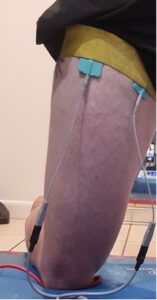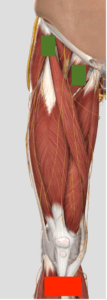By Michael Rand, personal trainer and triathlete.
Hip flexor recovery and the ABMMA PRO BMT Device
As an athlete currently beginning prep phase for my next series of races, and as an athlete currently rehabbing from a significant bout of injuries over the last 18 months, I would like to try and help you the practitioner / athlete / interested individual to improve your athletic and injury outcomes.
In my last blog, BMT & repetitive hamstring strain – an athlete’s perspective I wrote about my ongoing hamstring rehabilitation. This one will sort of be Part B of that blog. It is not going to be about the hamstring. It is going to be about causative effects and how I am now using my ABMMA PRO Device to improve my outcomes and hopefully allow me to maintain a consistent injury free approach over the 11 months and achieve my athletic goals.
Recently I have begun getting some weird lower back pain. Nothing too bad and after I warmed up could not feel anything at all. I had also begun getting some minor knee pain. It felt almost as though my knee was encased in a tourniquet and was getting squeezed. Again, as I warmed up it lessened and didn’t feel anything while training.
After some toing and froing, I basically gave myself a forehead slap and realised that while rehabbing my hamstring I had been ignoring the anterior musculature of the pelvis and leg. Namely hip flexors. I had slowly developed what Janda so succinctly named “Lower Cross Back Syndrome”. Being a bike rider, a runner and as most humans do these days a sitter. Over the last few years my hip flexors have slowly but surely shortened and had begun to create classic knee and lower back pain.
So what did I do? I grabbed ABMMA PRO and went to work on working my way out of pain. In the photo below you can see me in a modified hip flexor stretch, modified because obscured in the photo is a kettlebell that I am using to pin my foot and allow me to go deep in to external rotation in the hip.

In the photo you can also see I have placed two pads on the anterior portion of my thigh. 1 over the Rectus Femoris and the other near the attachments for the adductor complex. Also obscured is the positive pad under my patella tendon. The pad placement is illustrated in the second photo. In this position I began on a moderate intensity level of 10 on program 1 and gently went to where I began to feel tightness. Not pain! And from there began to PNF stretch the area by both taking the hip in to further hip extension and further external rotation.

After about 5 minutes in that position, I began to turn the intensity level up further to where I could feel most of the anterior muscles really start to dance. Still taking the hip in to extension and external rotation. As my hip has begun to open further during subsequent treatments, the force I am applying has slowly increased as well. In the end my ability to activate the hip flexors while in extension will improve their function over the while range of motion.
After repeating the procedure on the other hip flexor complex. I have been getting my device and still having it on program 1 and placing in over my lateral glutes and working them for up to 10 minutes. Straight after that I have begun doing single leg glute bridges to fully engage my glutes while I have maximal length in my hip flexors. The results so far have been promising. My back and knee pain have pretty much gone, and the original hamstring issue is to the point that I don’t feel it at all anymore.
I hope helps you even a little bit.
Michael Rand.
Other articles by this author:
BMT & Repetitive Hamstring Strain – An Athletes Perspective
BMT for Performance and Recovery


